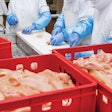
Whole genome sequencing has not only become an essential tool of food safety and regulatory agencies such as the U.S. Food and Drug Administration (FDA), U.S. Department of Agriculture (USDA) and the Centers for Disease Control and Prevention (CDC), the technology is being used more and more by food industry professionals to help manage the processes that ensure safe food production.
A commonly used definition for whole genome sequencing is the process of using a modern DNA sequencing platform with the goal of sequencing the majority of an organism’s genome.
While still a new technology, its fast pace of utility and use in the food industry has evinced both interest and concern. The U.S. Poultry & Egg Association (USPOULTRY), along with many industry groups, has been coordinating ongoing discussion through various food safety meetings and symposiums with the intention of bringing together experts to educate about whole genome sequencing technology among food industry professionals.
Government agencies have routinely used whole genome sequencing for various purposes. Most outbreak investigations, for example, use pulsed-field gel electrophoresis (PFGE) as their identification method. This method of genetic typing uses enzymes to break the bacterial DNA into pieces of different lengths. The pieces of DNA are then separated on a gel, and the different lengths form different bands on the gel. PFGE banding patterns tell us how similar bacteria are to one another.
Whole genome sequencing resetting rules
In the meantime, over the last decade, the ability to sequence the whole genome has become more accurate and cost effective thanks to the genetic typing method called whole genome sequencing. Researchers and public health agencies are beginning to use the technology for genetic typing of bacteria, including pathogens relevant to food safety.
While the rules to conduct foodborne outbreak investigations are being set, other uses for whole genome sequencing technology can be explored. This technology can also be used to identify microbial populations within food production settings. Whole genome sequencing can help to evaluate intervention effectiveness in controlling spoilage bacteria, for example.
Understanding the genetics of bacteria has been a priority of the poultry industry for many years. Genetic typing reveals whether bacteria have the genes for certain traits, such as antibiotic resistance, or have the genes that make them pathogenic (capable of making people sick). Genetic typing can also show how closely related bacteria are to one another, which can help determine the source of pathogenic bacteria.
Technical references available
In order to demonstrate its use and validate this process, USPOULTRY developed two technical references to develop plant biomapping studies using whole genome sequencing technology. These are intended to act as a tool in the implementation of testing protocols for the identification of microbial populations from carcass rinse, swabs or APC plate samples using WGS technology. The technical references are available to USPOULTRY members only and can be obtained by visiting www.uspoultry.org/foodsafety/.
















